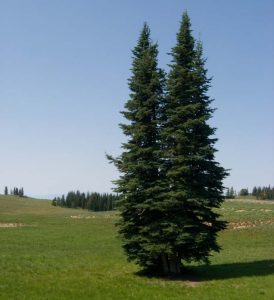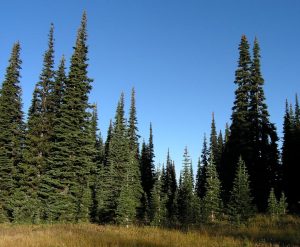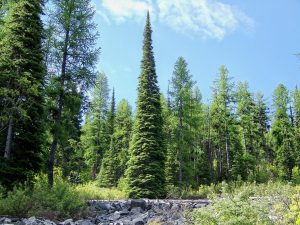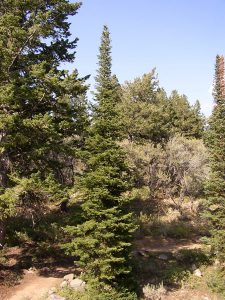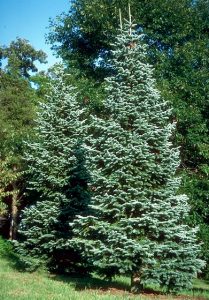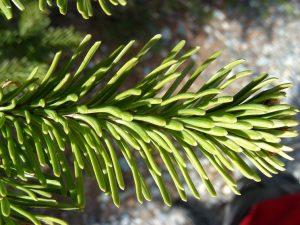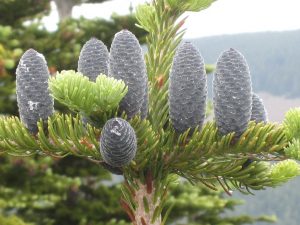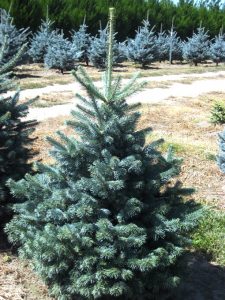Subalpine Fir
The Subalpine fir tree is the most widely distributed fir species in North America after the balsam fir. It is also the smallest of the true firs inhabiting the western United States.
Scientific Classification
| Kingdom | Plantae |
| Division | Pinophyta |
| Class | Pinopsida |
| Order | Pinales |
| Family | Pinaceae |
| Genus | Abies |
| Scientific Name | Abies lasiocarpa |
Quick Information
| Other Names | Rocky Mountain Fir, Alpine Fir, White Balsam, Western Balsam Fir, Corkbark Fir, Pino Real Blanco de las Sierras (Spanish) |
| Size | 66-115 ft (20-35 m); some have grown to 164 ft (50 m) |
| Identification | Leaves (Needles): 1 in (2.54 cm) long, flattened, thick in the middle, whitish blue sheen across all surfaces; rounded tips, some may be notched; arranged spirally, uniformly swept up, manicured appearance Fruits (Cones): 2-4 in (5-10 cm) long, slender, cylindrical, upright on the twigs usually in clusters, deciduous scales; cones purple at maturity Bark: Covered with resin-blisters, grayish green color when young; turns gray to white as it matures, continuous other than the base of larger trees; pockets of resin blisters found throughout the inner bark |
| Tree Type | Evergreen |
| Types/Varieties |
|
| Distribution/Range | Coast Range variety found in Pacific Coast Ranges, Olympic Mountains, Cascade Range from Southeast Alaska to California in the south Rocky Mountain variety found from Rocky Mountains in the eastern Alaskan Range to Colorado in the south Corkbark Fir found in New Mexico and Arizona |
| Habitat | Occurs in high mountains of Western North America, at heights of 980-2950 ft (298-900 m) |
| Hardiness Zones | 5-6 |
| Growth Rate | Slow |
| Lifespan | Oldest tree found in Wyoming aged 494 years |
| Growing Conditions | Winter Conditions: Mean winter temperature is between 5°F and 25°F (-15°C to -3.9°C) Summer Conditions: Mean summer temperature is between 45°F and 60°F (7.2°C to 15.6°C) Rainfall: More than 24 in (61 cm) Soil: Heavy Clayey, moist but not water-logged Light Requirements: Full to partial sun |
| Diseases & Pests | Western spruce budworm, western balsam bark beetle, silver fir beetle, fir engraver, balsam woolly adelgid; susceptible to wood-rotting fungi like the Indian paint fungus and bleeding conk fungus |
| Breeding System | Monoecious |
| Propagation | By seeds |
| Seed Dispersal | Cones fall off as the seeds ripen |
| Seedling Development | Germination rate is slow, requiring 6-8 weeks |
| Wildlife Value | Nesting sites for many animals and birds; needles are eaten by grouse; elks and deer eat the fruits and foliage during winter; squirrels, chipmunks and birds eat the seeds |
| Cultivars | A dwarf variant named Compacta |
| Uses | Christmas trees and ornamental trees, for paper manufacture, as firewood; native Americans drank and bathed in subalpine fir boiled water to purify themselves and promote hair growth |
| IUCN Conservation Status | Least Concern |
Comparison with some other fir species
Subalpine Fir vs. Douglas Fir
Needles of the Douglas fir are fragrant while subalpine fir needles have no such features.
Subalpine Fir vs. Balsam Fir
Subalpine fir is found across western North America, Balsam fir inhabits eastern North America.
Interesting Facts
- The ‘Compacta’ variant of the subalpine fir has been awarded the Royal horticultural Society’s ‘Award of Garden Merit.’
- It is one of the slowest growing firs, often growing about 1 ft in height in 15 years.
References
Published on September 29th 2016 by Sudipto Chakrabarti under Fir.
Article was last reviewed on 5th December 2024.


